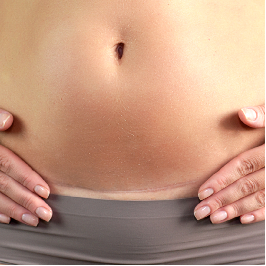Typically (unless you have been lucky all your life), almost everyone has at least one scar. A scar is an area of fibrous tissue that replaces damaged skin. Scars can vary in shape, color, length, and appearance. Scars occur after surgery, burns, and other injuries causing a break in the skin.
Therefore, scaring is a part of the body’s natural healing process.
Though a part of the natural process, scars sometimes can become very problematic, and today we will be looking closely at how this may be, especially concerning our women.
April is celebrated as Cesarean section awareness month. According to a news article published by the WHO in June 2021, Cesarean section (C-section) accounted for 21% of childbirths worldwide. That is one (1) in every five (5) births. Though C-sections have become so popular in society, many are unaware that it is classified as a major surgery, and this is because of the complications that can arise from this procedure.
In the short term, a C-section can lead to infections, hemorrhaging (excessive bleeding), placental complications, and often visceral injury (organ damage during surgery).
The long-term effects, however, are less commonly studied, but it is generally stated that it may lead to complications in subsequent pregnancies.
Another long-term complication unknown to many, especially women undergoing the surgery, is excessive scar tissue formation (under the skin) during the healing process. This excessive scar tissue is called Adhesions, and unfortunately, many women have never heard the term, even when going through the list of complications with their doctor before surgery.
Adhesions are web-like bands of scar tissue that extend and attach to the visceral organs in the area surrounding the surgical site.
Have you ever had a hug so tight it was a bit painful? Similarly, the Adhesions ‘hug’ the organs in the pelvic region and even in the abdomen, pulling them together and interfering with their natural positioning. It remains that way if not addressed.
This is happening on the inside, so one often cannot tell until the symptoms appear.
Women with C-section experience often notice some or all of these symptoms, and they often know and feel that something just ‘isn’t right,’ but they can’t explain it.
If you or someone close to you has done a Cesarean section, use the symptoms below as a checklist
Generally, in consultation with a Pelvic Floor Physiotherapist, these symptoms raise a high alarm with our C-section mommies. Their eyes widen as they typically hear everything they are experiencing being listed.
Yes, Adhesions are the culprit, and unfortunately, even with years of advanced medical studies, our women still are undereducated on the topic. That is why we are seeking to spread awareness during this month, especially as a part of the Pelvic Floor Specialty.
A Quick Guide to telling if you may have Adhesions forming after your C-section is to examine your scar, to see if it is indented (sinking towards your back), as in the picture below:

If it is, you most likely have Adhesions.
Women with darker, raised scars (often accompanied by tenderness) may also have Adhesions, as in the picture below.

So now that we know that Adhesions are possibly overtaking your abdominal and pelvic organs and other surfaces, is it mission impossible? Do you have to live with it?
Well, I’m glad you asked, because ‘NO!’ You do not have to!
This is where your trusted, experienced Pelvic Floor Physiotherapist comes into play.
Physiotherapists and Pelvic Floor therapists are trained in conservative techniques that address scar formation and adhesions. There are preventative measures that can be taken early after a C-section, and in the case of adhesions, there are curative measures as well.
Scar formation occurs in stages, and in the latter stages, when the fibrous tissue is being formed and laid down, Physiotherapists, as a preventative measure, can use methods such as taping, massage, and stretching to ensure proper alignment and to discourage adhesion formation.
However, in cases where the adhesions have been formed, and the patient has been experiencing symptoms, methods such as myofascial release (deep massage), exercise, and stretching the affected will be used to aid in the reduction (breaking up) of adhesions to bring significant relief in pain, infertility, and motion restrictions.
Heat therapy and appropriate tension to the area can promote circulation, and scar desensitization can be used to reduce pain.
On your initial visit, a complete medical history will be taken, and a comprehensive assessment will be done of the scar and surrounding areas to determine the best course of treatment going forward.
Scars are normal. Adhesions are not.
We are here to help. We’re here to give you the treatment you deserve. Click here to contact a Pelvic Floor Physiotherapist Today!